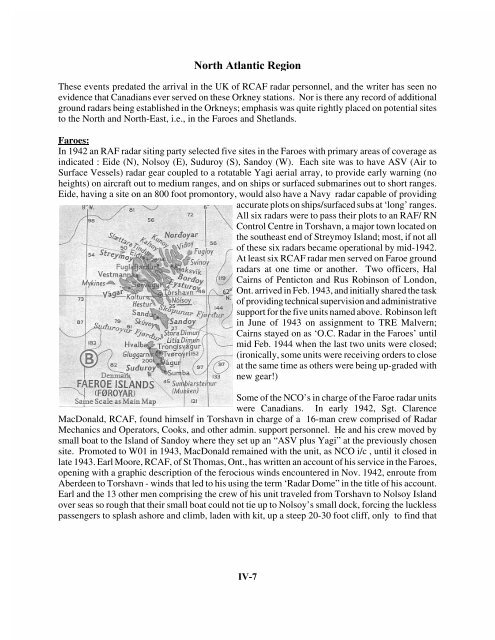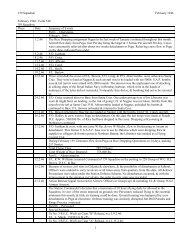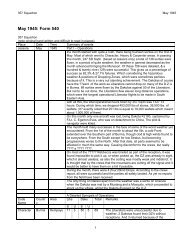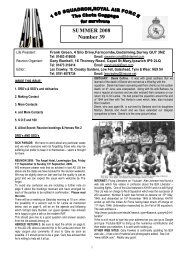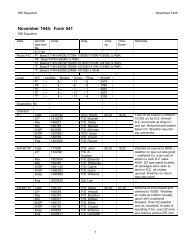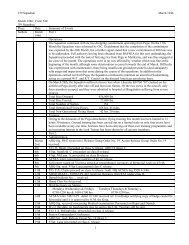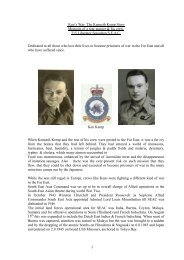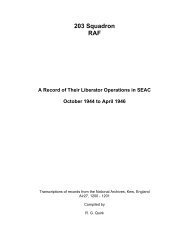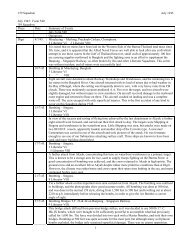RCAF Radar Personnel in WWII -North Atlantic Region-
RCAF Radar Personnel in WWII -North Atlantic Region-
RCAF Radar Personnel in WWII -North Atlantic Region-
Create successful ePaper yourself
Turn your PDF publications into a flip-book with our unique Google optimized e-Paper software.
1RUWK $WODQWL 5HJLRQ<br />
These events predated the arrival <strong>in</strong> the UK of <strong>RCAF</strong> radar personnel, and the writer has seen no<br />
evidence that Canadians ever served on these Orkney stations. Nor is there any record of additional<br />
ground radars be<strong>in</strong>g established <strong>in</strong> the Orkneys; emphasis was quite rightly placed on potential sites<br />
to the <strong>North</strong> and <strong>North</strong>-East, i.e., <strong>in</strong> the Faroes and Shetlands.<br />
Faroes:<br />
In 1942 an RAF radar sit<strong>in</strong>g party selected five sites <strong>in</strong> the Faroes with primary areas of coverage as<br />
<strong>in</strong>dicated : Eide (N), Nolsoy (E), Suduroy (S), Sandoy (W). Each site was to have ASV (Air to<br />
Surface Vessels) radar gear coupled to a rotatable Yagi aerial array, to provide early warn<strong>in</strong>g (no<br />
heights) on aircraft out to medium ranges, and on ships or surfaced submar<strong>in</strong>es out to short ranges.<br />
Eide, hav<strong>in</strong>g a site on an 800 foot promontory, would also have a Navy radar capable of provid<strong>in</strong>g<br />
accurate plots on ships/surfaced subs at ‘long’ ranges.<br />
All six radars were to pass their plots to an RAF/ RN<br />
Control Centre <strong>in</strong> Torshavn, a major town located on<br />
the southeast end of Streymoy Island; most, if not all<br />
of these six radars became operational by mid-1942.<br />
At least six <strong>RCAF</strong> radar men served on Faroe ground<br />
radars at one time or another. Two officers, Hal<br />
Cairns of Penticton and Rus Rob<strong>in</strong>son of London,<br />
Ont. arrived <strong>in</strong> Feb. 1943, and <strong>in</strong>itially shared the task<br />
of provid<strong>in</strong>g technical supervision and adm<strong>in</strong>istrative<br />
support for the five units named above. Rob<strong>in</strong>son left<br />
<strong>in</strong> June of 1943 on assignment to TRE Malvern;<br />
Cairns stayed on as ‘O.C. <strong>Radar</strong> <strong>in</strong> the Faroes’ until<br />
mid Feb. 1944 when the last two units were closed;<br />
(ironically, some units were receiv<strong>in</strong>g orders to close<br />
at the same time as others were be<strong>in</strong>g up-graded with<br />
new gear!)<br />
Some of the NCO’s <strong>in</strong> charge of the Faroe radar units<br />
were Canadians. In early 1942, Sgt. Clarence<br />
MacDonald, <strong>RCAF</strong>, found himself <strong>in</strong> Torshavn <strong>in</strong> charge of a 16-man crew comprised of <strong>Radar</strong><br />
Mechanics and Operators, Cooks, and other adm<strong>in</strong>. support personnel. He and his crew moved by<br />
small boat to the Island of Sandoy where they set up an “ASV plus Yagi” at the previously chosen<br />
site. Promoted to W01 <strong>in</strong> 1943, MacDonald rema<strong>in</strong>ed with the unit, as NCO i/c , until it closed <strong>in</strong><br />
late 1943. Earl Moore, <strong>RCAF</strong>, of St Thomas, Ont., has written an account of his service <strong>in</strong> the Faroes,<br />
open<strong>in</strong>g with a graphic description of the ferocious w<strong>in</strong>ds encountered <strong>in</strong> Nov. 1942, enroute from<br />
Aberdeen to Torshavn - w<strong>in</strong>ds that led to his us<strong>in</strong>g the term ‘<strong>Radar</strong> Dome” <strong>in</strong> the title of his account.<br />
Earl and the 13 other men compris<strong>in</strong>g the crew of his unit traveled from Torshavn to Nolsoy Island<br />
over seas so rough that their small boat could not tie up to Nolsoy’s small dock, forc<strong>in</strong>g the luckless<br />
passengers to splash ashore and climb, laden with kit, up a steep 20-30 foot cliff, only to f<strong>in</strong>d that<br />
,9


